DNA Barcoding to Confirm the Morphological Identification of the Coral Trees (Erythrina spp., Fabaceae) in the Ancient Gardens of Naples (Campania, Italy)
Abstract
:1. Introduction
2. Material and Methods
3. Results
3.1. Historical Sources
3.2. Herbaria Specimens
3.3. Erythrina Plants in the Gardens of Naples at Present
3.4. Genetic Analysis
4. Discussion and Conclusions
Author Contributions
Funding
Acknowledgments
Conflicts of Interest
Appendix A
Appendix B
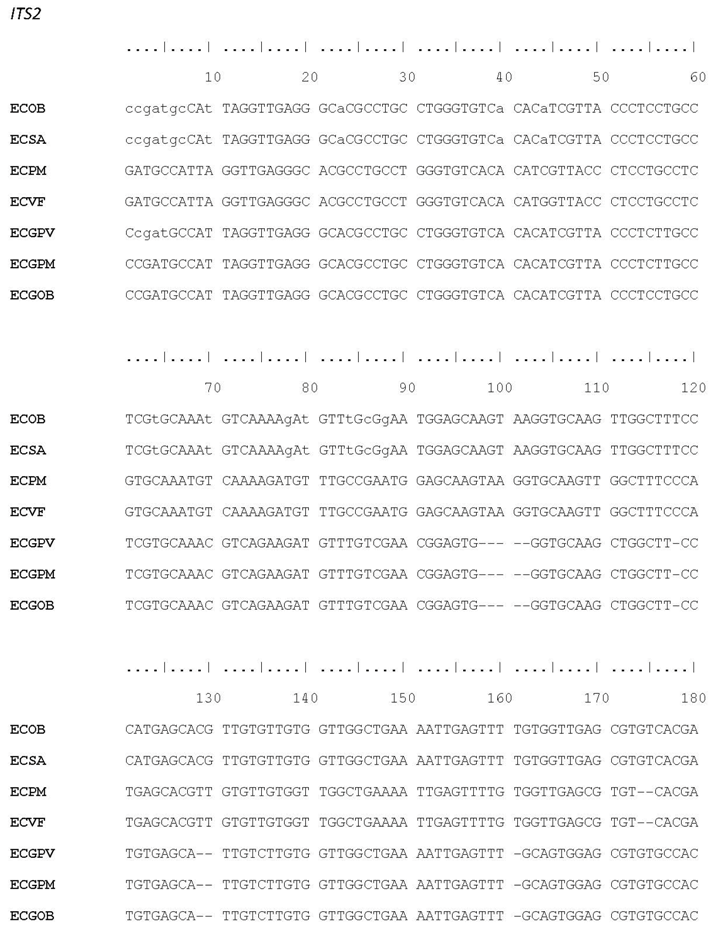
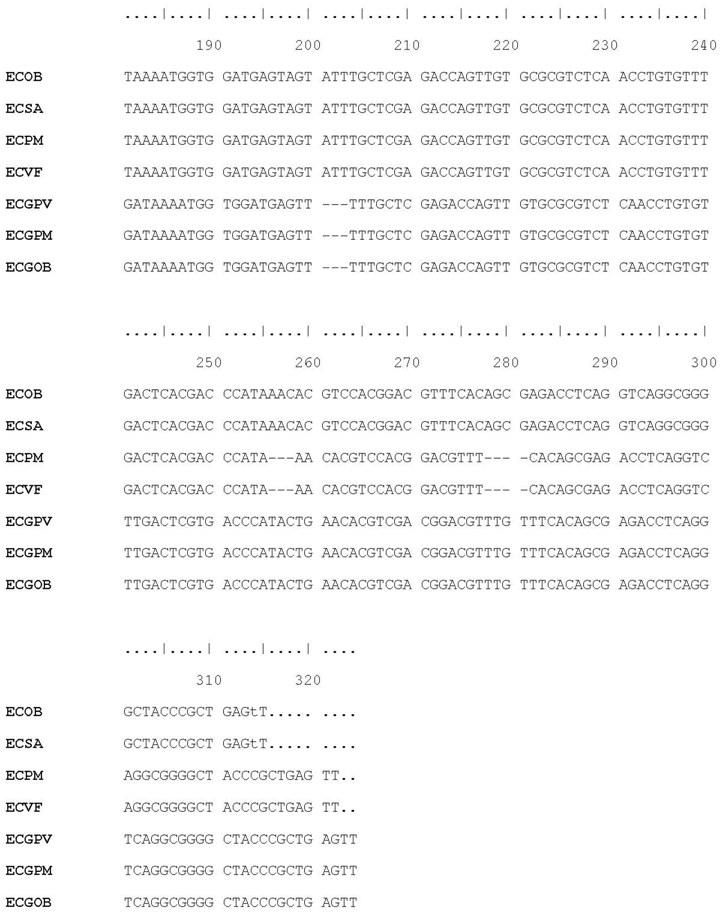
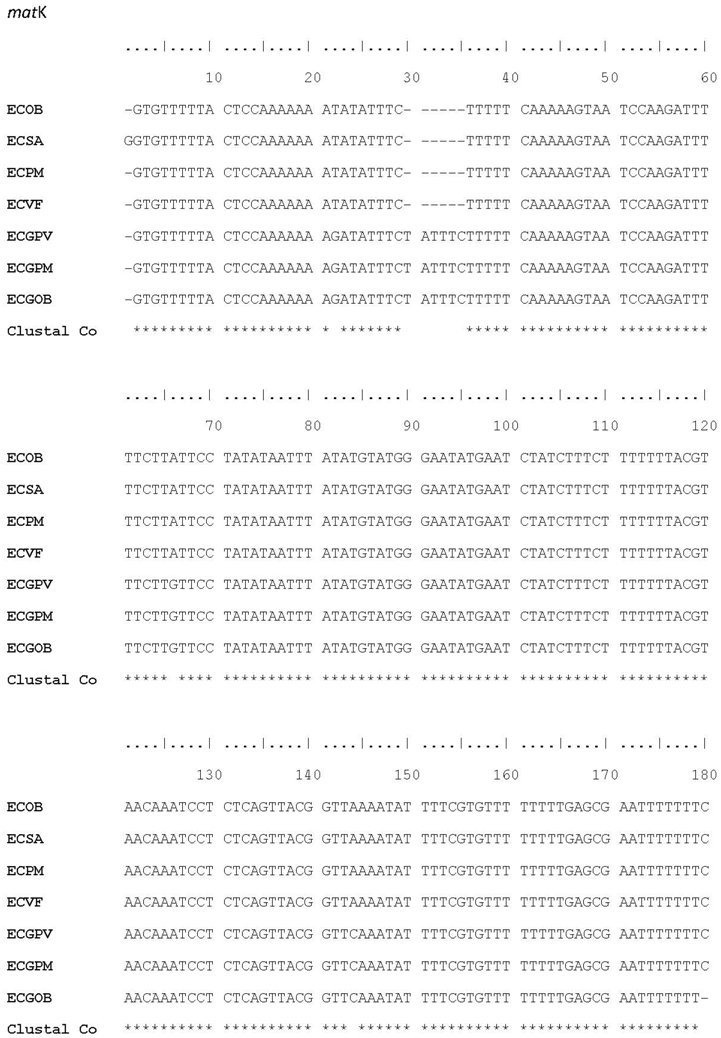
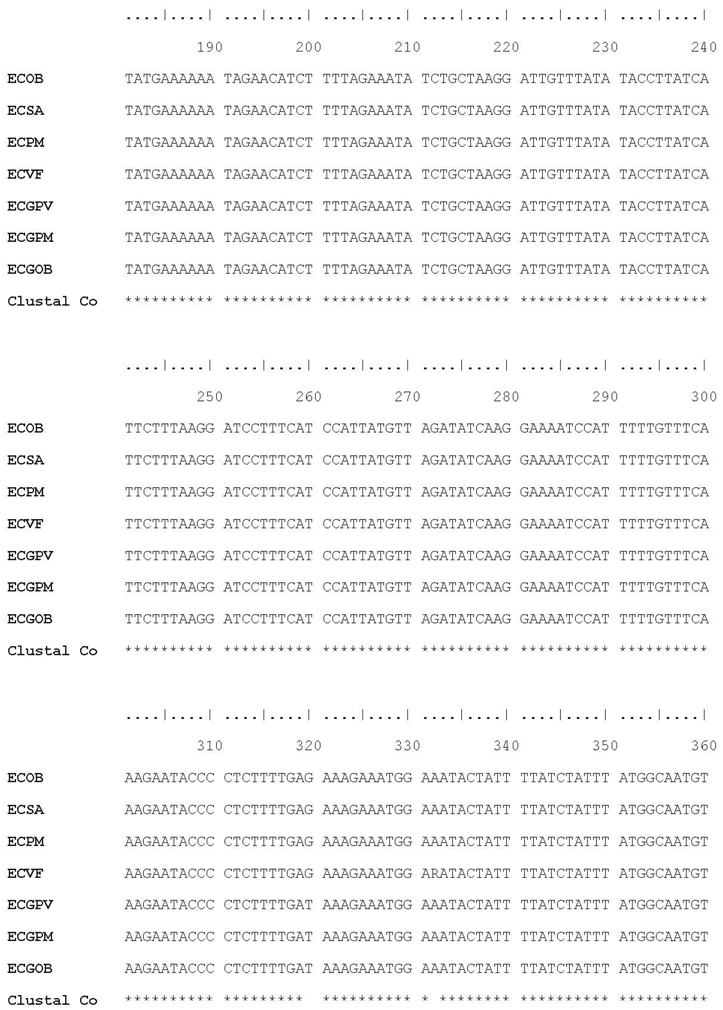
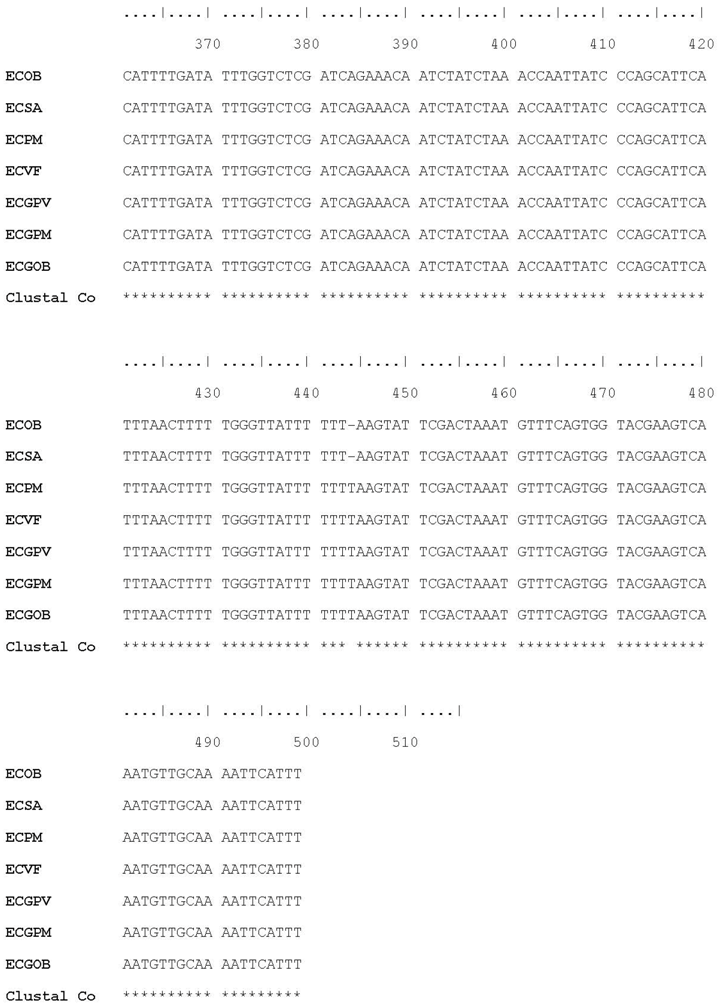
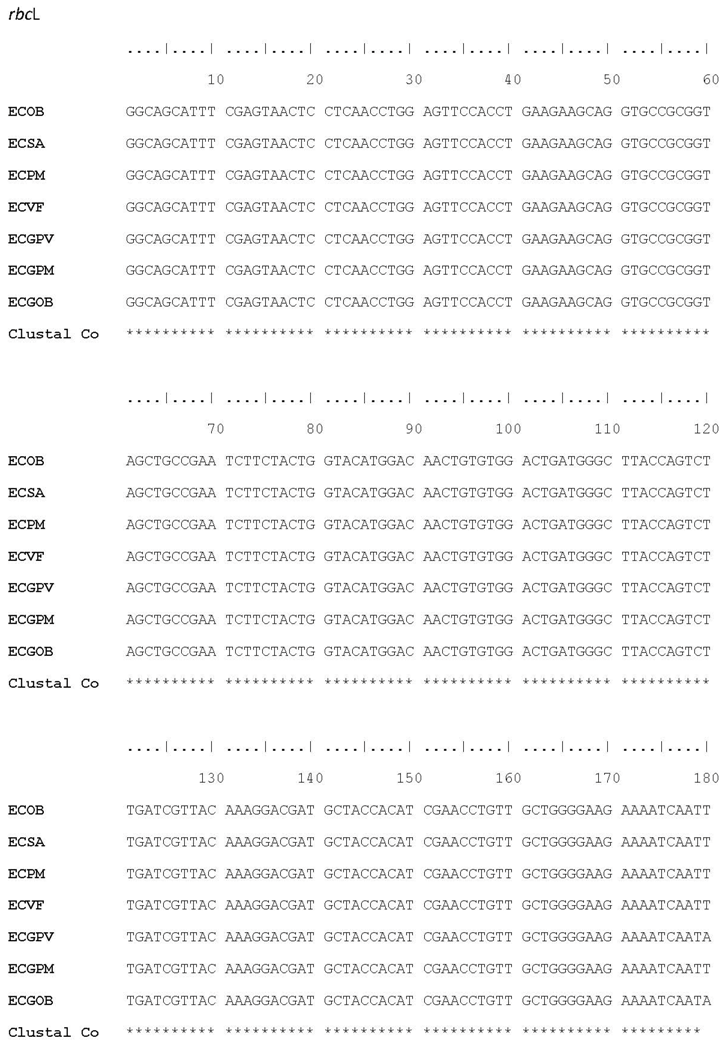
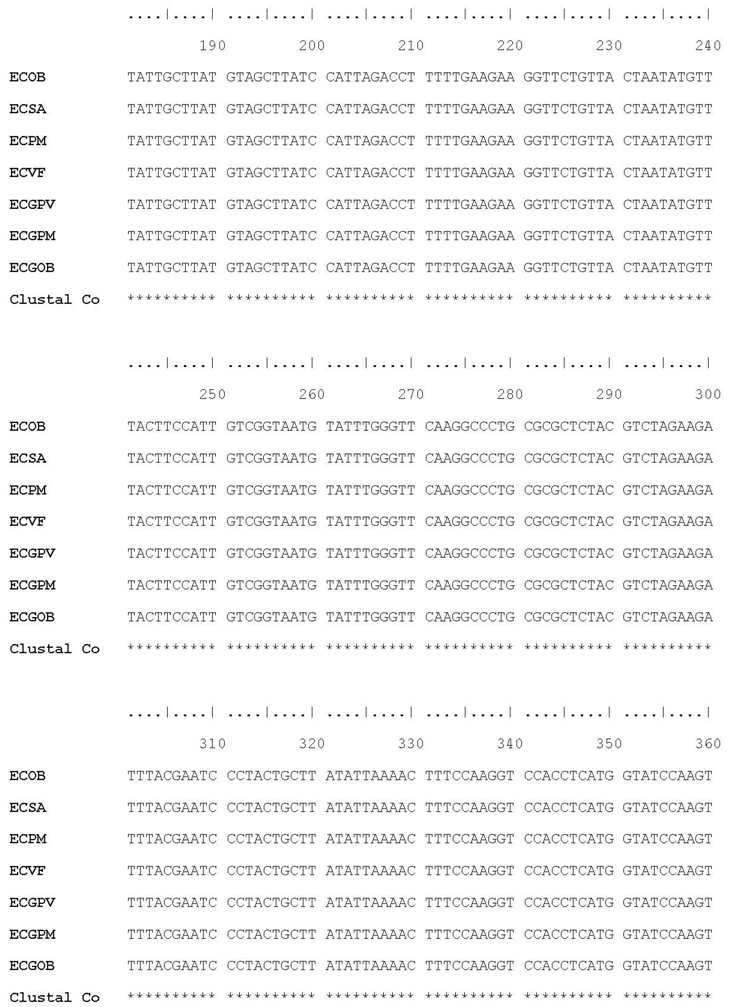
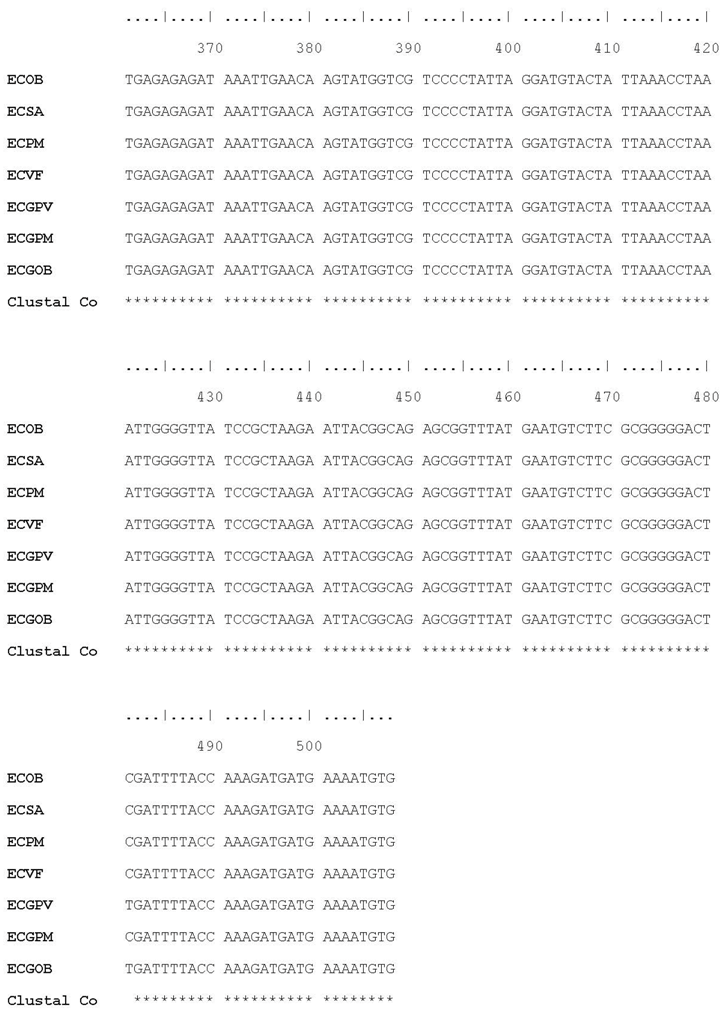
References
- Krukoff, B.A.; Barneby, R.C. Conspectus of species of the genus Erythrina. Lloydia 1974, 37, 332–459. [Google Scholar]
- ILDIS. International Legume Database & Information Service. 2015. Available online: www.ildis.org (accessed on 15 July 2017).
- Mabberley, D.J. Mabberley’s Plant-Book: A Portable Dictionary of Plants, Their Classification and Uses, 4th ed.; Cambridge University Press: Cambridge, UK, 2017. [Google Scholar]
- Russo, R.O.; Baguinon, N.T. Erythrina fusca Loureiro [Internet] Record from Proseabase; Faridah Hanum, I., van der Maesen, L.J.G., Eds.; PROSEA (Plant Resources of South-East Asia) Foundation: Bogor, Indonesia, 1997; Available online: http://www.proseanet.org (accessed on 10 April 2017).
- Kass, D.L. Erythrina Species-Pantropical Mutipurpose Tree Legumes. In Forage Tree Legumes in Tropical Agriculture; Gutteridfge, R.C., Shelton, M.H., Eds.; Tropical Grassland Society of Australia Inc.: Brisbane Australia, 1998; ISBN 0958567719. [Google Scholar]
- Pellow, B.J.; Henwood, M.J.; Carolin, R.C. Flora of the Sidney Region, 5th ed.; Sydney University Press: Sydney, Australia, 2009; ISBN 9781920899301. [Google Scholar]
- Nesom, G.L. Key to native and cultivated species of Erythrina (Fabaceae) in the USA and comments on naturalization of E. crista-galli. Phytoneuron 2015, 29, 1–8. [Google Scholar]
- Gillet, J.B. The Fruit and Seeds of Erythrina brucei and the Identify of E. abyssinica. Kew Bull. 1962, 15, 425–429. [Google Scholar] [CrossRef]
- Maniero, F. Fitocronologia d’Italia; Olschki, L.S.: Florence, Italy, 2000; ISBN 882224897X. [Google Scholar]
- A Catalogue of Trees, Shrubs, Plants, Flower, Seeds, & c., Sold by Gordon, Dermer and Thomson, Seed and Nurseryment, at Mile End, Near London; Gale Ecco, Print Editions: Farmington Hills, MI, USA, 2010.
- Anonymous. De L’Imprimerie de I. H. Decker. Catalogue des Vegetaux en Tout Genre, que les Amateurs du Jardinage, et de L’agriculture Peuvent se Procurer dans L’etablissement des Freres Baumann Proprietaires, Cultivateurs et Pepinieristes a Bollwiller (par Ensisheim) au Departement du Haut-Rhin; Colmar. Biblioteca Nazionale di Napoli: Napoli, Italy, 1819; p. 10. [Google Scholar]
- Todaro, A. Hortus Botanicus Panormitanus. Tomus Primus et Secundus (1876–1892); Ristampa analitica a cura dell’Accademia Nazionale di Scienze Lettere e Arti di Palermo: Palermo, Italy, 1993. [Google Scholar]
- Domina, G.; Raimondo, F.M. Erythrina viarum Tod. (Leguminosae) from the Palermo Botanical Garden. Webbia 2011, 66, 235–238. [Google Scholar] [CrossRef]
- Graefer, J. Synopsis Plantarum Regii Viridarii Casertani. 1803. Available online: www.ortobotanico.unina.it (accessed on 15 October 2017).
- Coats, A.M. Forgotten Gardeners, II: John Graefer. Gard. Hist. Soc. Newlett. 1972, 16, 4–7. [Google Scholar] [CrossRef]
- Desmond, R. Dictionary of British and Irish Botanists and Horticulturists; Taylor & Francis; The Naturali History Museum: London, UK, 1994. [Google Scholar]
- Terracciano, N. Cenno Intorno al Giardino Botanico Della Real Casa in Caserta ed a Certe Piante Rare che vi si Coltivano; Biblioteca dell’Orto Botanico di Napoli: Napoli, Italy, 1876; p. 33. [Google Scholar]
- Celesti-Grapow, L.; Pretto, F.; Carli, E.; Blasi, C. (Eds.) Flora Vascolare Alloctona e Invasiva Delle Regioni D’Italia; Casa Editrice Università La Sapienza: Roma, Italy, 2010; p. 208. [Google Scholar]
- Del Guacchio, E.; La Valva, V. The non-native vascular flora of Campania (southern Italy). Plant Biosyst. 2017, 152, 767–779. [Google Scholar] [CrossRef]
- La Valva, V.; Guarino, C.; De Natale, A.; Cuozzo, V.; Menale, B. La flora del Parco di Capodimonte di Napoli. Delpinoa 1991–1992, 33–34, 143–177. [Google Scholar]
- Barone Lumaga, M.R.; Menale, B. L’Hortus Camaldulensis. In AA.VV.: La Botanica a Napoli nel periodo borbonico. Delpinoa 2000, 42, 43–45. [Google Scholar]
- Menale, B.; Barone Lumaga, M.R. I giardini botanici napoletani che precedettero l’istituzione del Real Orto Botanico. In AA.VV.: La Botanica a Napoli nel periodo borbonico. Delpinoa 2000, 42, 9–11. [Google Scholar]
- Menale, B.; Barone Lumaga, M.R.; De Matteis Tortora, M. Il ruolo dell’Orto Botanico di Napoli nella coltivazione, nello studio e nella diffusione delle specie esotiche durante il periodo tenoreano. In AA.VV.: La Botanica a Napoli nel periodo borbonico. Delpinoa 2000, 42, 35–38. [Google Scholar]
- Menale, B.; Di Prisco, C.; Amato, G. La Villa Comunale di Napoli: Cenni storici e analisi della componente vegetale. Delpinoa 2005, 47, 145–154. [Google Scholar]
- Del Guacchio, E.; Cennamo, P.; Vàzquez Torres, M.; Menale, B. When art meets taxonomy: Identity of Erythrina laeta (Fabaceae). Phytotaxa 2016, 255, 144–152. [Google Scholar] [CrossRef]
- Del Guacchio, E.; Manning, J.; Menale, B.; Caputo, P. A posy of neglected Tritonia species (Iridaceae) from the erstwhile Garden of Camaldoli (Naples, Italy). Taxon 2016, 65, 1409–1414. [Google Scholar] [CrossRef]
- Tenore, M. Catalogo del Regal Giardino Botanico di Napoli. Napoli, Stamperia Reale. 1807. Available online: http://www.ortobotanico.unina.it/Catalogo_P/OBN_1807/Catalogo.htm (accessed on 10 October 2017).
- Tenore, M. Catalogus Plantarum Horti Regii Neapolitani. Napoli, Appendix Prima. ex Typ. amulliana. 1813. Available online: https://books.google.it (accessed on 10 October 2017).
- Tenore, M. Catalogus Plantarum Horti Regii Neapolitani. Napoli, Appendix Prima. Editio Altera ex Typ. Diarii Enciclopedici. 1819. Available online: http://www.ortobotanico.unina.it/Catalogo_P/1813ap_altera/Catalogo.htm (accessed on 10 October 2017).
- Tenore, M. Index Seminum in Horto Botanico Neapolitano 1839, Collectorum. 1839. Available online: http://www.ortobotanico.unina.it/Catalogo_P/1839/Catalogo3.htm (accessed on 10 October 2017).
- Tenore, M. Index Seminum in Horto Botanico Neapolitano 1840 Collectorum. 1840. Available online: http://www.ortobotanico.unina.it/Catalogo_P/1840/Catalogo4.htm (accessed on 10 October 2017).
- Tenore, M. Index Seminum in Regio Horto Botanico Neapolitano 1842 Collectorum. 1842. Available online: http://www.ortobotanico.unina.it/Catalogo_P/altri_cataloghi/1842.pdf (accessed on 15 October 2017).
- Tenore, M. Catalogo delle piante che si coltivano nel R. Orto Botanico di Napoli. Napoli, Tip. Dell’Aquila di V. Puzziello. 1845. Available online: https://books.google.it/ (accessed on 15 October 2017).
- Tenore, M. Semina quae in Horto Regio Neapolitano. 1848. Available online: http://www.ortobotanico.unina.it/Catalogo_P/altri_cataloghi/1848.pdf (accessed on 15 October 2017).
- Tenore, M. Index Seminum quae anno 1855 in Horto R. Botanico Neapolitano. 1855. Available online: http://www.ortobotanico.unina.it/Catalogo_P/altri_cataloghi/1855.pdf (accessed on 15 October 2017).
- Pasquale, G.A. Index Seminum In Horto R. Neapolitano An. 1866 Collectorum. Napoli-Stabilimento Tipografico Ghio. 1866. Available online: http://www.ortobotanico.unina.it/Catalogo_P/altri_cataloghi/1866.pdf (accessed on 15 October 2017).
- Pasquale, G.A. Catalogo del Real Botanico. Napoli, Tip. Ghio. 1867. Available online: https://books.google.it/ (accessed on 15 October 2017).
- Cesati, V. Index Seminum in Horto R. Neapolitano an. 1867 Collectorum. Napoli, 1867; Stamperia Govenativa. Available online: http://www.ortobotanico.unina.it/Catalogo_P/altri_cataloghi/1867.pdf (accessed on 10 October 2017).
- Cesati, V. Index Seminum in Horto R. Neapolitano an. 1869 Collectorum. Napoli, 1869; Stamperia Govenativa. Available online: http://www.ortobotanico.unina.it/Catalogo_P/altri_cataloghi/1869.pdf (accessed on 10 October 2017).
- Cesati, V. Index Seminum in Horto R. Neapolitano an. 1872 Collectorum. 1872. Available online: http://www.ortobotanico.unina.it/Catalogo_P/altri_cataloghi/1872.pdf (accessed on 10 October 2017).
- Dehnhardt, F. Catalogus Plantarum Horti Camaldulensis; Ortobotanico: Napoli, Italy, 1829; Available online: http://www.ortobotanico.unina.it/Catalogo_P/H_camaldulensis2/Horti_camaldulensis_1829.pdf (accessed on 15 October 2017).
- Dehnhardt, F. Catalogus Plantarum Horti Camaldulensis, Editio Secunda; Ortobotanico: Napoli, Italy, 1832; Available online: http://www.ortobotanico.unina.it/Catalogo_P/H_camaldulensis/Catalogo.htm (accessed on October 2017).
- Aliotta, G. Catalogo delle piante coltivate nell’Orto Botanico di Napoli. Supplemento al quaderno N° 18 di Agricoltura Ambiente. Edizioni ITPA, Italy. 1985; 96. [Google Scholar]
- Krukoff, B.A. The American species of Erythrina. Brittonia 1939, 3, 205–337. [Google Scholar] [CrossRef]
- Bean, A.R. A taxonomic revision of Erythrina L. (Fabaceae: Faboideae) in Australia. Austrobaileya 2008, 7, 641–658. [Google Scholar]
- Polhill, R.M. Erythrina L. In Flore des Mascareignes; Bosser, J., Cadet, T., Guého, J., Marais, W., Eds.; The Sugar Industry Research Institute: Moka, Mauritius, 1990; Volume 80, pp. 116–119. [Google Scholar]
- Sa, R.; Gilbert, M.G. Erythrina Linnaeus. In Flora of China; Wu, Z.Y., Raven, P.H., Hong, D.Y., Eds.; Science Press: Beijing, China; Missouri Botanical Garden Press: St. Louis, MO, USA, 2010; Volume 10, pp. 237–239. [Google Scholar]
- Doyle, J.J.; Doyle, J.L. A rapid DNA isolation procedure for small quantities of fresh leaf tissue. Phytochem. Bull. 1987, 19, 11–15. [Google Scholar]
- De Luca, D.; Cennamo, P.; Del Guacchio, E.; Di Novella, R.; Caputo, P. Conservation and genetic characterisation of common bean landraces from Cilento region (southern Italy): High differentiation in spite of low genetic diversity. Genetica 2018, 146, 29–44. [Google Scholar] [CrossRef] [PubMed]
- Hall, T.A. BioEdit: A user-friendly biological sequence alignment editor and analysis program for Windows 95/98/NT. Nucleic Acids Symp. 1999, 41, 95–98. [Google Scholar]
- Altschul, S.F.; Madden, T.L.; Schaèffer, A.A.; Zhang, J.; Zhang, Z.; Miller, W.; Lipman, J.D. Gapped BLAST and PSI-BLAST: A new generation of protein database search programs. Nucleic Acids Res. 1997, 25, 3389–3402. [Google Scholar] [CrossRef] [PubMed]
- Thompson, J.D.; Higgins, D.G.; Gibson, T.J.; Clustal, W. Improving the sensitivity of progressive multiple sequence alignment through sequence weighting, position-specific gap penalties and weight matrix choice. Nucleic Acids Res. 1994, 22, 4673–4680. [Google Scholar] [CrossRef] [PubMed]
- Ronquist, F.; Huelsenbeck, J.P. MrBayes. Bayesian phylogenetic inference under mixed models. Bioinformatics 2003, 19, 1572–1574. [Google Scholar] [CrossRef] [PubMed]
- Darriba, D.; Taboada, G.L.; Doallo, R.; Posada, D. jModelTest 2: More models, new heuristics and parallel computing. Nat. Methods 2012, 9, 772. [Google Scholar] [CrossRef] [PubMed]
- Lanave, C.; Preparata, G.; Sacconce, C.; Serio, G. A new method for calculating evolutionary substitution rates. J. Mol. Evol. 1984, 20, 86–93. [Google Scholar] [CrossRef] [PubMed]
- Tavare, S. Some probabilistic and statistical problems on the analysis of DNA sequences. Lect. Math. Life Sci. 1986, 17, 57–86. [Google Scholar]
- Kimura, M. A simple method for estimating evolutionary rates of base substitutions through comparative studies of nucleotide sequences. J. Mol. Evol. 1980, 16, 111–120. [Google Scholar] [CrossRef] [PubMed]
- TROPICOS. Missouri Botanical Garden. Available online: http://www.tropicos.org (accessed on 15 July 2017).
- Agostini, R. Un poco noto Orto Botanico privato Napoletano: L’Hortus Camaldulensis al Vomero. Delpinoa 1962, 3, 407–454. [Google Scholar]
- Intendenza di Napoli, III versamento ff. 3079; Archivio di Stato Napoli (ASNA): Naples, Italy, 1839.
- Intendenza di Napoli, III versamento ff. 3083; Archivio di Stato Napoli (ASNA): Naples, Italy, 1838.
- Intendenza di Napoli, III versamento ff. 3099; Archivio di Stato Napoli (ASNA): Naples, Italy, 1854–1855.
- Pasquale, G.A. Una passeggiata per la Villa Reale di Chiaja. Napoli [Naples]: Tipografia F. Azzolino. 1842. Available online: http://www.ortobotanico.unina.it/OBN4/mv/biblioteca/pdf/Pasquale_Villa_Chiaia_1842.pdf (accessed on 15 October 2017).
- Pasquale, G.A. La Bughenvillea spettabile nella Villa Reali di Napoli. In Cosmorama Pittorico Anno X. Milano; SAS: Parma, Italy, 1844; pp. 271–272. Available online: https://books.google.it/ (accessed on 15 October 2017).
- Aiello, G. Napoli e i Luoghi Celebri Delle Sue Vicinanze; Tip. Gaetano Nobile: Napoli, Italy, 1845; Volume 1. [Google Scholar]
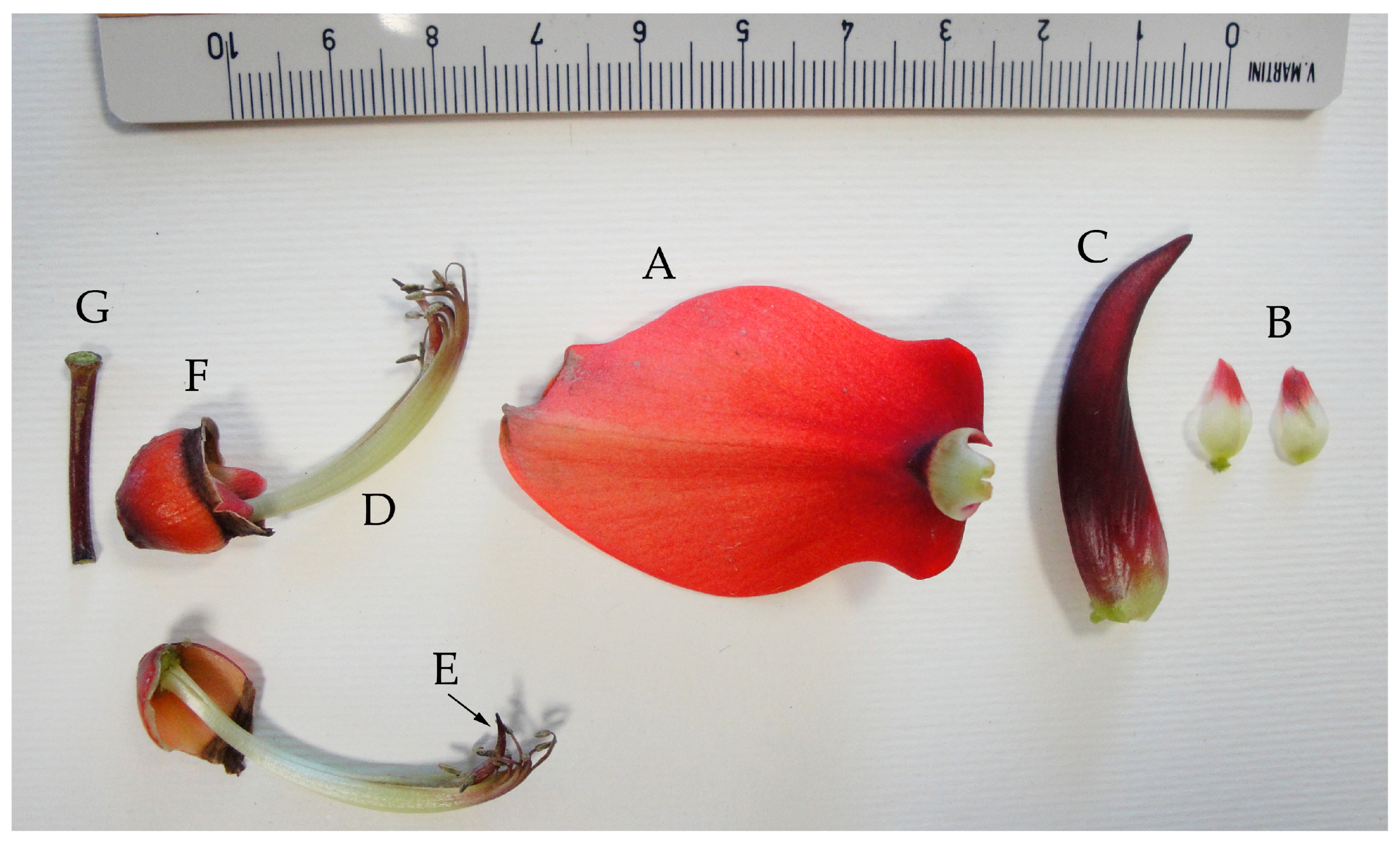
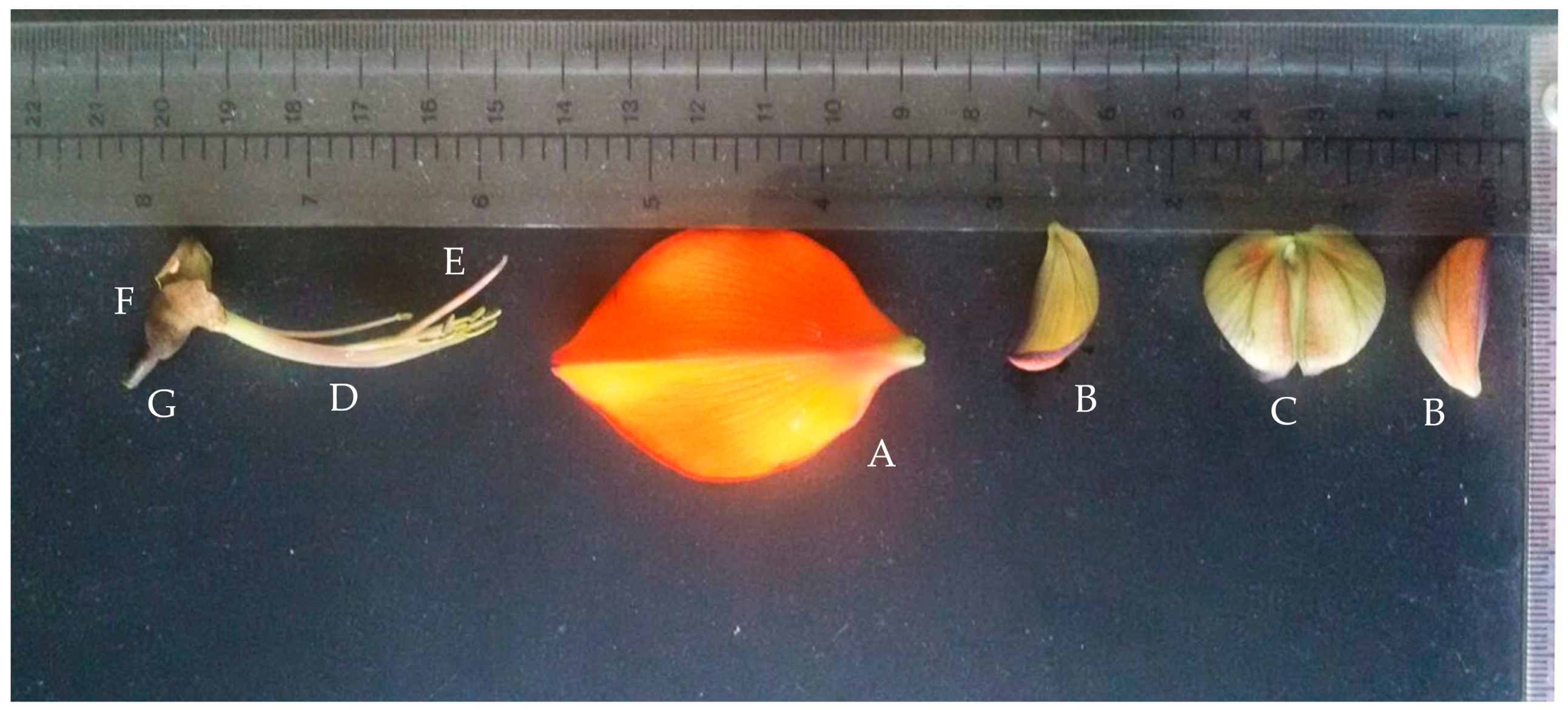
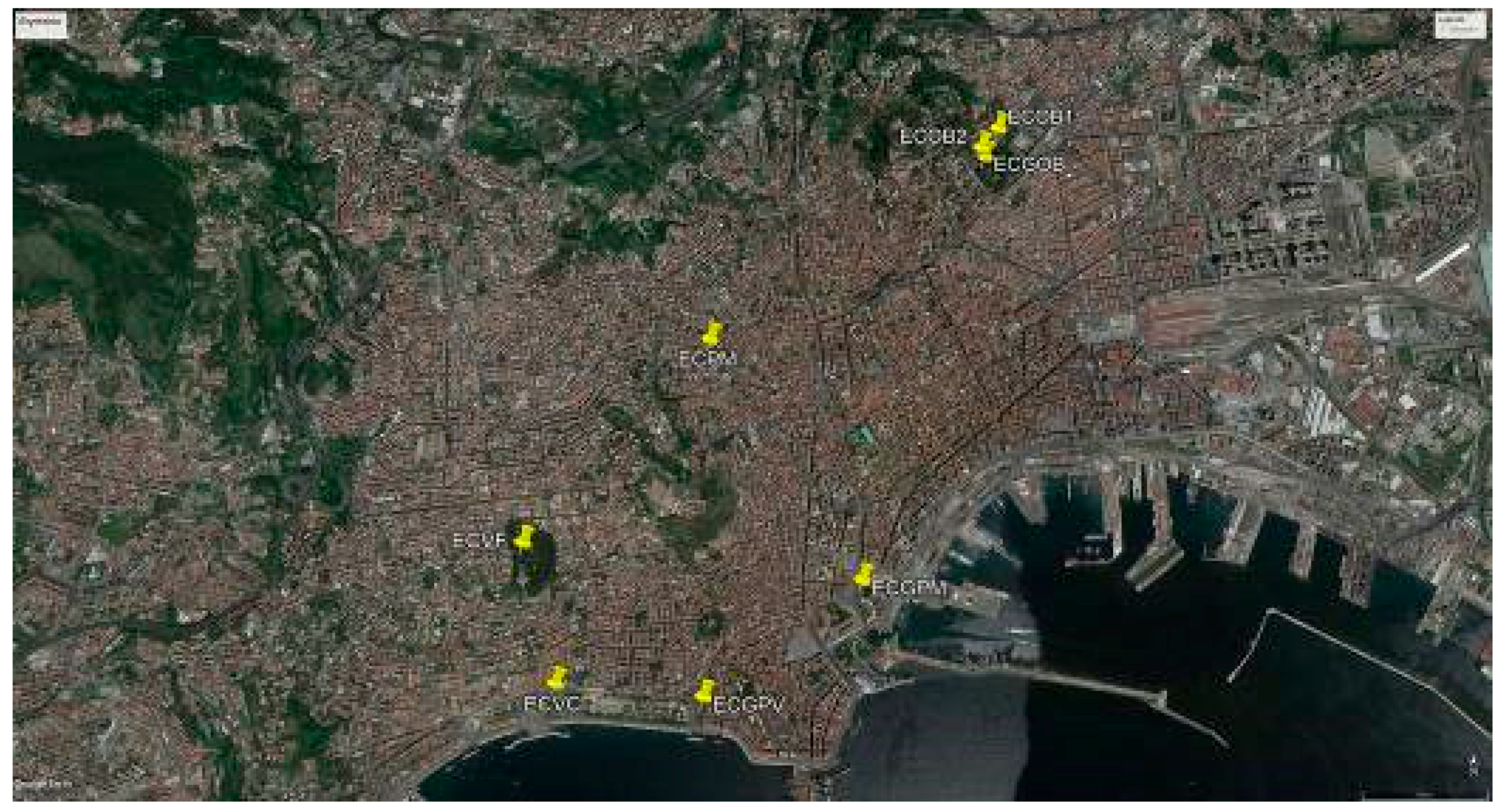
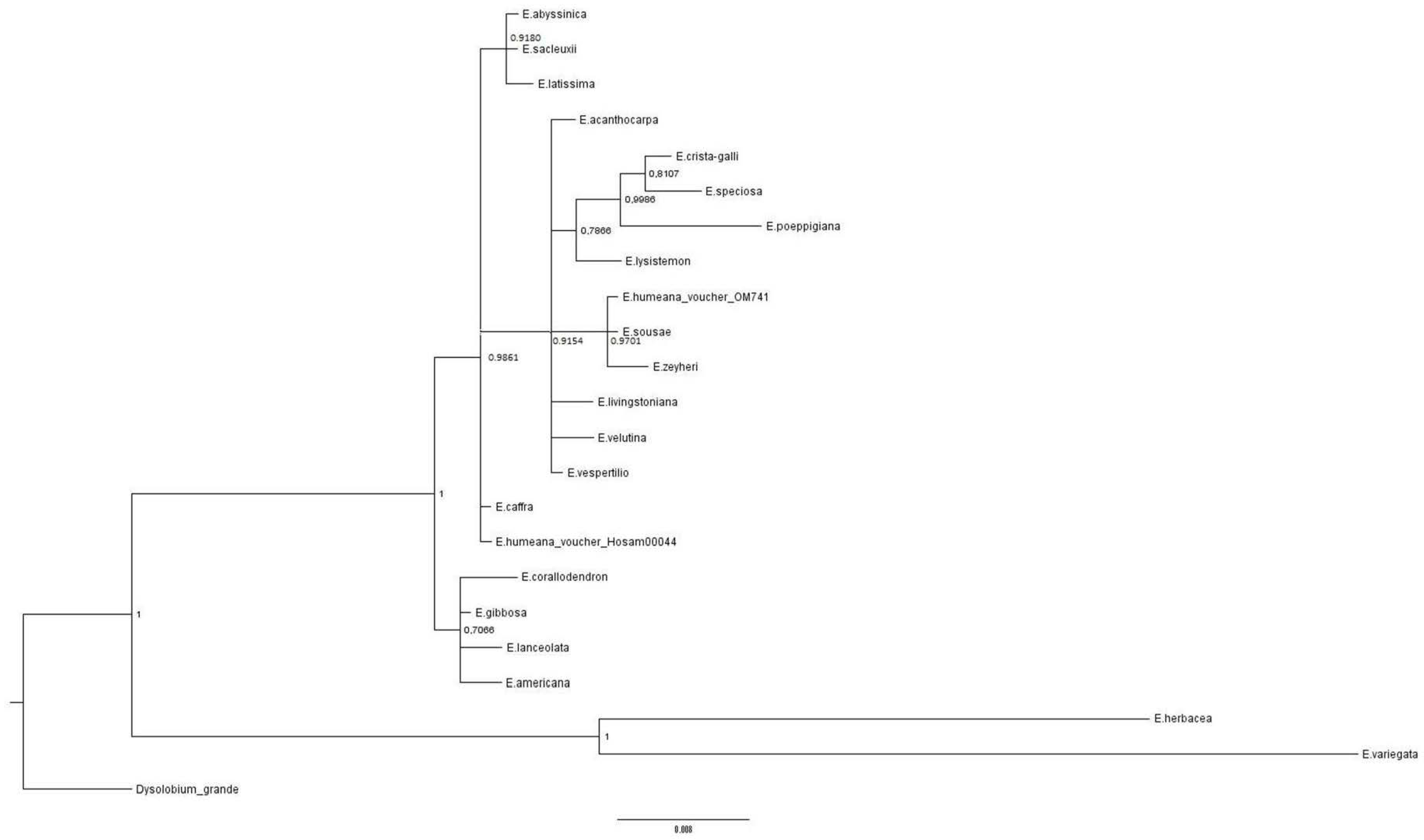
| Code | Taxon | Origin | Identities | Description2 | GenBank no. |
|---|---|---|---|---|---|
| ECOB | Erythrina caffra | Botanical Garden, Naples, Italy (2016) | 293/313 (94%) | Erythrina velutina | JX856571 (ITS2) |
| ECSA | Erythrina caffra | Manie van der Schijff Botanical Garden, Petroria, South Africa (2016) | 293/313 (94%) | Erythrina velutina | JX856571 (ITS2) |
| ECVF | Erythrina caffra | Villa Floridiana, Naples, Italy (2016) | 294/313 (94%) | Erythrina velutina | JX856572 (ITS2) |
| ECPM | Erythrina caffra | Piazza Mazzini, Naples, Italy (2016) | 293/313 (94%) | Erythrina velutina | JX856571 (ITS2) |
| ECCPV | Erytryna crista-galli | Piazza Vittoria, Naples, Italy (2016) | 311/312 (99%) | Erythrina crista-galli | FN825780 (ITS2) |
| ECCPM | Erytryna crista-galli | Piazza Municipio, Naples, Italy (2016) | 311/312 (99%) | Erythrina crista-galli | FN825780 (ITS2) |
| ECGOB | Erytryna crista-galli | Botanical Garden, Naples, Italy (2016) | 312/312 (100%) | Erythrina crista-galli | FN825781 (ITS2) |
| ECOB | Erythrina caffra | Botanical Garden, Naples, Italy (2016) | 497/497 (100%) | Erythrina caffra | JQ412236 (matK) |
| ECSA | Erythrina caffra | Manie van der Schijff Botanical Garden, Petroria, South Africa (2016) | 497/497 (100%) | Erythrina caffra | JQ412236 (matK) |
| ECPM | Erythrina caffra | Villa Floridiana, Naples, Italy (2016) | 496/499 (99%) | Erythrina caffra | JQ412236 (matK) |
| ECVF | Erythrina caffra | Piazza Mazzini, Naples, Italy (2016) | 495/499 (99%) | Erythrina caffra | JQ412236 (matK) |
| ECGPV | Erythrina crista-galli | Piazza Vittoria, Naples, Italy (2016) | 511/514 (99%) | Erythrina crista-galli | AY386869 (matK) |
| ECGPM | Erythrina crista-galli | Piazza Municipio, Naples, Italy | 511/514 (99%) | Erythrina crista-galli | AY386869 (matK) |
| ECGOB | Erythrina crista-galli | Botanical Garden, Naples, Italy | 510/514 (99%) | Erythrina crista-galli | AY386869 (matK) |
| ECOB | Erythrina caffra | Botanical Garden, Naples, Italy (2016) | 469/469 (100%) | Erythrina caffra | JQ412356 (rbcL) |
| ECSA | Erythrina caffra | Manie van der Schijff Botanical Garden, Petroria, South Africa (2016) | 469/469 (100%) | Erythrina caffra | JQ412356 (rbcL) |
| ECPM | Erythrina caffra | Villa Floridiana, Naples, Italy (2016) | 469/469 (100%) | Erythrina caffra | JQ412356 (rbcL) |
| ECVF | Erythrina caffra | Piazza Mazzini, Naples, Italy (2016) | 469/469 (100%) | Erythrina caffra | JQ412356 (rbcL) |
| ECGPV | Erythrina crista-galli | Piazza Vittoria, Naples, Italy (2016) | 505/508 (99%) | Erythrina crista-galli | Z70170 (rbcL) |
| ECGPM | Erythrina crista-galli | Piazza Municipio, Naples, Italy | 503/508 (99%) | Erythrina crista-galli | Z70170 (rbcL) |
| ECGOB | Erythrina crista-galli | Botanical Garden, Naples, Italy | 505/508 (99%) | Erythrina crista-galli | Z70170 (rbcL) |
| Taxon | Genbank Acc. No. | |
|---|---|---|
| matK | rbcL | |
| Erythrina abyssinica Lam. | JX518054 | JX572563 |
| Erythrina americana Mill. | This paper | This paper |
| Erythrina acanthocarpa E.Mey. | KF147397 | KF147471 |
| E. caffra Thunb. | JQ412236 | JQ412356 |
| Erythrina corallodendron L. | KJ012577 | KJ082284 |
| E. crista-galli L. | AY386869 | Z70170 |
| Erythrina gibbosa Cufod. | JQ587632 | JQ591749 |
| Erythrina herbacea L. | KJ772770 | KJ773492 |
| Erythrina humeana Spreng. (voucher Hosam 00044) | JX495709 | JX571824 |
| E. humeana (voucher OM741) | JF270763 | JF265413 |
| Erythrina lanceolata Standl. | JQ587635 | JQ591753 |
| Erythrina latissima E.Mey. | This paper | JF265414 |
| Erythrina livingstoniana Baker | JX517778 | JX572564 |
| Erythrina lysistemon Hutch | JF270764 | JF265415 |
| Erythrina poeppigiana (Walp.) Skeels | KJ012578 | KJ082285 |
| Erythrina sacleuxii Hua | KX146309 | KU568087 |
| Erythrina sousae Krukoff & Barneby | EU717411 | EU717270 |
| Erythrina speciosa Andrews | KX816365 | AB045801 |
| Erythrina variegata L. | KU587466 | KU559206 |
| Erythrina velutina Willd. | KY045858 | JX856697 |
| Erythrina vespertilio Benth. | JX850049 | JX856700 |
| Erythrina zeyheri Harv. | JX517714 | JX572565 |
| Dysolobium grande (Wall. ex Benth.) Prain | KX713094 | KX527443 |
| Species | Tenore (1807), [27] | Tenore (1813), [28] | Tenore (1819), [29] | Dehnhardt (1829), [41] | Dehnhardt (1832), [42] | Tenore (1839), [30] | Tenore (1840), [31] | Tenore (1842), [2] | Tenore (1845), [33] | Tenore (1848), [34] | Tenore (1855), [35] | Pasquale (1866), [36] | Pasquale (1867), [37] | Cesati (1867), [38] | Cesati (1869), [39] | Cesati (1872), [40] | Aliotta (1982), [43] | 2017 * |
|---|---|---|---|---|---|---|---|---|---|---|---|---|---|---|---|---|---|---|
| E. americana Mill. | x 1 | x 1 | ||||||||||||||||
| E. caffra Thunb. | x, x 2 | x | ||||||||||||||||
| E. corallodendron L. | x | x | x | x | x | x | ||||||||||||
| E. crista-galli L. | x 3 | x 4 | x | x | x, x 4, x 5 | x | x | x | x, x 5 | x 5 | x | x | x | x | ||||
| E. herbaceaea L. | x | x | x | x6 | x | |||||||||||||
| E. humeana Spreng. | x | |||||||||||||||||
| E. mitis Jacq. | x 7 | |||||||||||||||||
| E. speciosa Andrews | x | x | x | x | ||||||||||||||
| E. variegata L. | x 8 | x 8 | ||||||||||||||||
| E. velutina Willd. | x | x | ||||||||||||||||
| Unidentified | x 9 | x 10 |
| E. crista-galli Type Samples | Collection Sites | UTM Coordinates (m) | UTM Coordinates (m) |
|---|---|---|---|
| ECGPM | Piazza Municipio | 436,948,76 E | 4,521,091,25 N |
| ECGPV | Piazza Vittoria | 436,041,31 E | 4,520,442,85 N |
| ECGOB | Orto Botanico | 437,741,73 E | 4,523,616,01 N |
| E. caffra Type Samples | Collection Sites | UTM Coordinates (m) | UTM Coordinates (m) |
| ECVC | Villa Comunale | 435,218,25 E | 4,520,535,67 N |
| ECVF | Villa Floridiana | 435,073,49 E | 4,521,358,05 N |
| ECPM | Piazza Mazzini | 436,126,69 E | 4,522,527,87 N |
| ECOB1 | Orto Botanico | 437,828,39 E | 4,523,790,37 N |
| ECOB2 | Orto Botanico | 437,723,28 E | 4,523,670,84 N |
© 2018 by the authors. Licensee MDPI, Basel, Switzerland. This article is an open access article distributed under the terms and conditions of the Creative Commons Attribution (CC BY) license (http://creativecommons.org/licenses/by/4.0/).
Share and Cite
De Luca, A.; Sibilio, G.; De Luca, P.; Del Guacchio, E. DNA Barcoding to Confirm the Morphological Identification of the Coral Trees (Erythrina spp., Fabaceae) in the Ancient Gardens of Naples (Campania, Italy). Plants 2018, 7, 43. https://doi.org/10.3390/plants7020043
De Luca A, Sibilio G, De Luca P, Del Guacchio E. DNA Barcoding to Confirm the Morphological Identification of the Coral Trees (Erythrina spp., Fabaceae) in the Ancient Gardens of Naples (Campania, Italy). Plants. 2018; 7(2):43. https://doi.org/10.3390/plants7020043
Chicago/Turabian StyleDe Luca, Adriana, Giancarlo Sibilio, Paolo De Luca, and Emanuele Del Guacchio. 2018. "DNA Barcoding to Confirm the Morphological Identification of the Coral Trees (Erythrina spp., Fabaceae) in the Ancient Gardens of Naples (Campania, Italy)" Plants 7, no. 2: 43. https://doi.org/10.3390/plants7020043
APA StyleDe Luca, A., Sibilio, G., De Luca, P., & Del Guacchio, E. (2018). DNA Barcoding to Confirm the Morphological Identification of the Coral Trees (Erythrina spp., Fabaceae) in the Ancient Gardens of Naples (Campania, Italy). Plants, 7(2), 43. https://doi.org/10.3390/plants7020043





